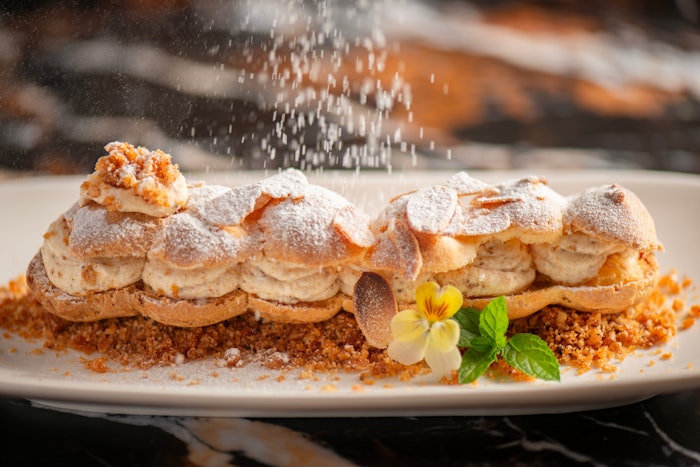
I have always loved traditional French sweets, decadent desserts and anything chocolate. It’s only natural that being a perfumer, I am bound to create gourmand notes of all kinds. They are an ode to nostalgia bringing back wonderful childhood memories and reminding me of a time that is now long gone.
Read this article in Perfumer & Flavorist+'s April 2024 issue.
At the heart of those gourmands, subtly lie pyrazines. They are a keynote in perfumery, yet secretly hide in our formulas, giving them depth, character and a stunning dimension. Mastering the art of mixing and adjusting their concentration can be quite an arduous task.
Versatility
Another string to their bow, due to their low usage level, is their ability to blur the lines of analytical techniques, making it harder for competitors to copy or extract the scent. Many kinds of pyrazine molecules are available. They share a similar aromatic heterocyclic structure, with two nitrogen atoms ‘face-to-face’ amongst the carbon patterns. Some have connected alkyl groups, and tend to be sweet, nutty, and chocolatey. Those containing alkoxy groups are green, vegetable-like, savory, or even galbanum-like. The most well-known example is galbazine.
Pyrazines can be found in nature, developed in wine and are a component in other plant-based sources such as bread, nuts, bell peppers or cocoa. They are produced from organic synthesis reactions, such as Gutknecht’s condensation or Staedel-Rugheimer’s pyrazine synthesis. As natural molecules, they can also be extracted from vegetables, or obtained through fermentation processes. It’s fascinating how they can be used in both natural and conventional perfumery.
 Pyrazines can be found in nature, developed in wine and are a component in other plant-based sources such as bread, nuts, bell peppers or cocoa.Adobe Stock
Pyrazines can be found in nature, developed in wine and are a component in other plant-based sources such as bread, nuts, bell peppers or cocoa.Adobe Stock
Jean-Claude Ellena mentioned in his Journal of a Perfumer that he used them cautiously as a blend in his creation ‘Bois Farine’ from L’Artisan Parfumeur. This is one of the first fragrances that struck me as a young perfumery student, with its incredibly unique creamy, powdery dry, and salty woodiness, and a little je ne sais quoi that I could not quite pinpoint at the time. Until I became more advanced in my perfumery education, it was then that the magic of pyrazines unfolded.
Their multi-faceted super-power extends to forge a bridge between the world of flavors and fragrances. I am lucky to work at a company (Bell Flavors & Fragrances) where both divisions collaborate under the same roof, piquing my curiosity and inspiring me every day. After all, our senses of taste and smell are so closely related as they activate similar zones in our brains and can facilitate a wide array of emotions: surprise, pleasure or even disgust. When I first encountered pure pyrazines in the lab, I remember thinking they smelled like extra strong dirty old socks with a hint of creamy cooked rice—but in a pleasant way!
Formulating
In Singapore, where I lived and worked from 2009 to 2017, there was a bold pungent-smelling, bright green-looking herb called Pandan leaf that had a very similar odor, with an added coconut milk impression. This Southeast Asian plant was intriguing, and I later discovered that it was used to flavor and color regional sweet delicacies, such as biscuits, cakes, beverages and even rice (Thai cendol, Malaysian seri muka, Filipino buko pandan, Peranakan chiffon cake, etc.). It inspired me to imagine an accord that would evoke this memory, using a combination of pyrazines, including one with a sulfur atom 2-methylthio3(5/6)-methyl pyrazine reminiscent of toasted popcorn and peanut, with a green vegetable nuance.
 Many kinds of pyrazine molecules are available. Some have connected alkyl groups, and tend to be sweet, nutty, and chocolatey.Adobe Stock
Many kinds of pyrazine molecules are available. Some have connected alkyl groups, and tend to be sweet, nutty, and chocolatey.Adobe Stock
I then reproduced one of my favorite French desserts the Paris-Brest puff pastry base garnished with hazelnut praliné and cream. I renamed it ‘Paris-Chicago’ where Bell’s headquarters are located and in reference to my dual citizenship and culture. This was part of an emerging trend program for gourmands and nostalgic scents a few years back, and I was amazed at how fun it was to create those, having such a precise image in mind and taste in my mouth. I ended up using five different pyrazines to complete my vision, plus other high-impact ingredients.
Another challenging, yet regressively delicious accord to re-create was the famous hazelnut chocolate spread that I eventually used as a note in personal and air care. This well-known treat needed to take shape to be an accessory that I could use and interchange in various capacities. Sweet pyrazines, such as 2-acetyl pyrazine or trimethyl-2,3,5- pyrazine were key to obtaining the character and unique hazelnut yumminess, building a smooth and milky feel, evocative of the creamy texture of the product. Bon appétit!
Final Thoughts
With endless combinations and possibilities, no matter what the creative idea is, pyrazines come in handy, and their extreme intensity and versatility make them great candidates for high-impact formulation. Nowadays, with sustainability at the center of all interests and concerns in the fragrance industry, they make sense. Pyrazines remain non-toxic to the environment and do not present an immediate health risk, certainly even less at the ‘microscopic’ levels they call for. Life would be so boring without them!










